Equal access to high-quality, affordable healthcare can lead to better patient outcomes, including improved quality of life and lower rates of premature deaths. Digital technologies can be a crucial tool in advancing health equity. However, rapidly evolving technology may also worsen exclusion, introduce unintended barriers to healthcare, and worsen disparities among different populations.
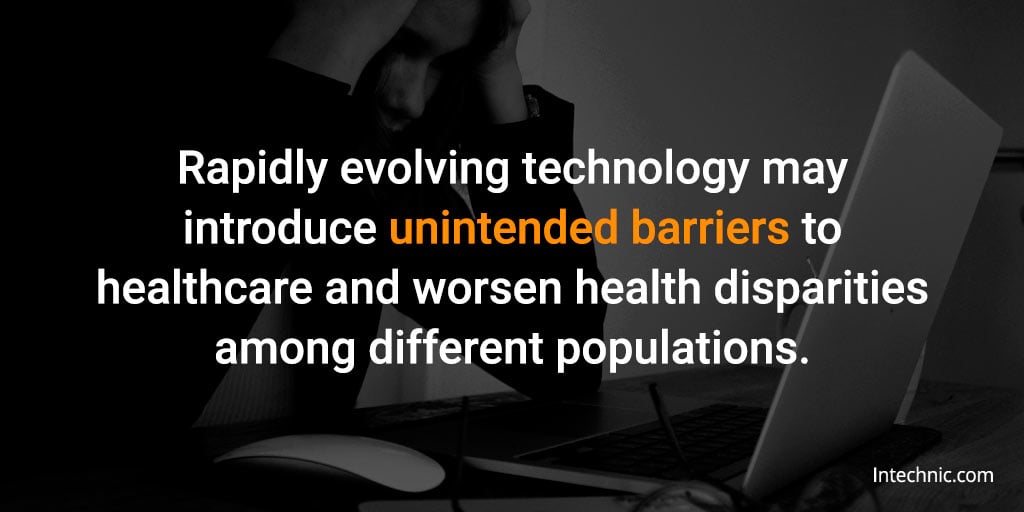
The importance of health equity and inclusion in healthcare
Health equity is the concept of fairness and justice in healthcare, where all individuals have a fair and just opportunity to access healthcare services and attain their highest level of health. Inclusion refers to creating an environment where everyone feels valued, respected, and empowered, regardless of their ethnicity, gender, sexual orientation, disability, or other characteristics.
Health equity and inclusion are critical for addressing and reducing health disparities, such as higher rates of chronic diseases or poorer health outcomes, which disproportionately affect certain populations, including disadvantaged groups.1,2
Not only are health equity and inclusion crucial for promoting fairness, social justice, and human rights in public health, but advancing equal access to healthcare can also significantly increase healthcare efficiency and lower cost.
Studies estimate that health disparities cost approximately $93 billion in excess medical care costs and $42 billion in lost productivity per year, in addition to economic losses due to premature deaths.3
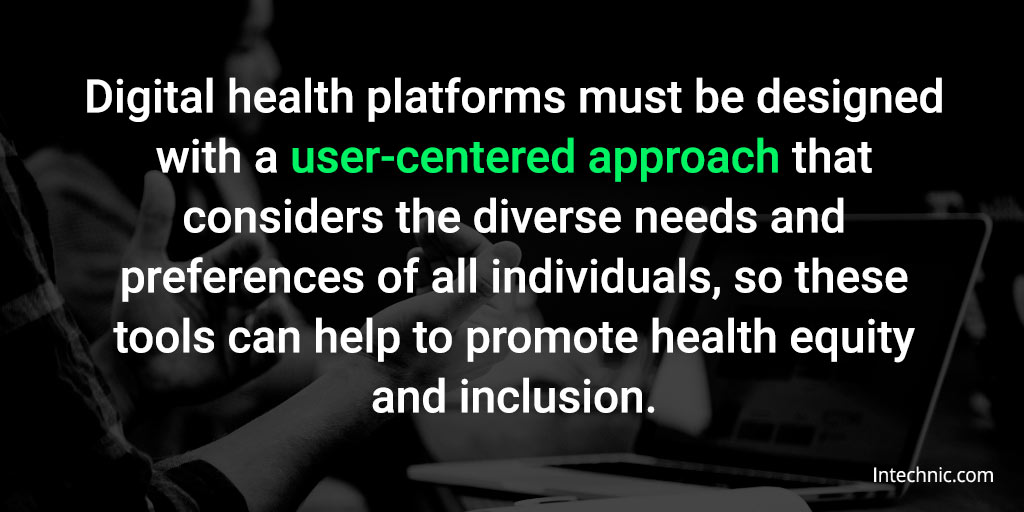
The role of digital user experience in health equity and inclusion
Digital user experience (UX) plays a significant role in achieving equity and inclusion in healthcare. Access to digital health tools and technologies, such as telehealth, mobile apps, and online portals, has become increasingly important in modern healthcare. These digital tools can improve access to healthcare services, enable self-care, improve disease prevention, and enhance communication between patients and healthcare providers.
However, if digital healthcare programs overlook the cultural, linguistic, and economic disparities between different populations, they are far less likely to be taken up by disadvantaged patients, which in turn increases the risk of worsening health disparity.4
For digital health tools to truly promote health equity and inclusion, they must be designed with a user-centered approach tthat considers the diverse needs and preferences of all individuals, including those from vulnerable populations. This involves incorporating user-centered design principles, addressing language barriers through multilingual interfaces, providing targeted health information for diverse populations, ensuring digital health tools are inclusive for people with disabilities, and collaborating with underserved communities in the design process.
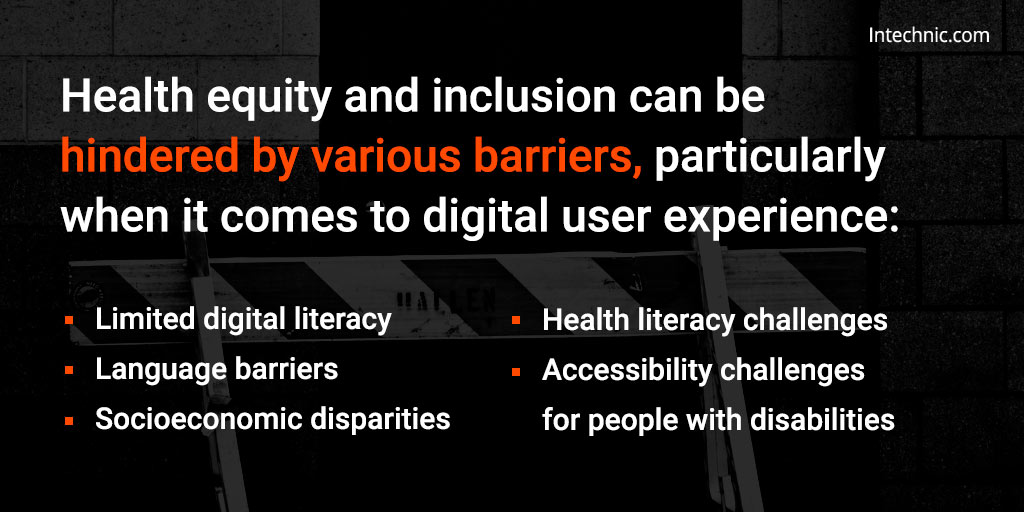
Health disparities and barriers to inclusion in digital experiences
Health inequities and disparities refer to the disproportionate differences in healthcare access and health outcomes among different populations or communities. These disparities can be influenced by various factors, including race, ethnicity, socioeconomic status, education, geographic location, gender identity, sexual orientation, mental health status, disability, health insurance coverage, and other social determinants of health status. Health disparities often result in underserved populations facing higher rates of illness, disease, and mortality.
Inclusion in healthcare can be hindered by various barriers, particularly in the context of digital user experience. Some common barriers to inclusion in healthcare include:
- Limited digital literacy can create a barrier for some individuals, particularly those who are older or come from disadvantaged groups. Limited digital skills can affect the ability to effectively use health technologies, such as healthcare portals and apps.
- Language barriers can pose significant challenges to inclusion in healthcare, particularly for individuals with limited English proficiency. Accessing digital health tools, understanding health information, and communicating with healthcare providers can be difficult for those who do not speak the primary language used in health technology.
- Socioeconomic disparities, including income and education levels, can impact inclusion in healthcare. Limited access to digital devices, internet connectivity, and other technological resources can hinder individuals from effectively utilizing digital health tools.
- Health literacy challenges occur when a person cannot easily understand and use information to make informed decisions about one's health. Limited health literacy can be a significant barrier to inclusion in healthcare, as individuals may struggle to understand complex information provided through digital health technologies.
- Accessibility challenges can pose a problem for people with disabilities, including those with visual, auditory, or motor impairments. Lack of accessibility features, such as alternative text for images, closed captioning for videos, or compatibility with assistive technologies, can limit the usability and effectiveness of digital health tools.
Addressing health disparities through UX is crucial for contributing to ongoing societal efforts to promote health equity and inclusion in healthcare. By designing digital health technologies that are usable, accessible, and inclusive, we can break down barriers and ensure that individuals from underprivileged groups can effectively access, understand, and utilize these tools to achieve optimal health.
This includes considering the diverse needs, perspectives, and challenges faced by marginalized communities in the design and implementation of digital health technologies, and actively addressing these disparities through user-centered design, accessibility features, language support, and health literacy considerations.
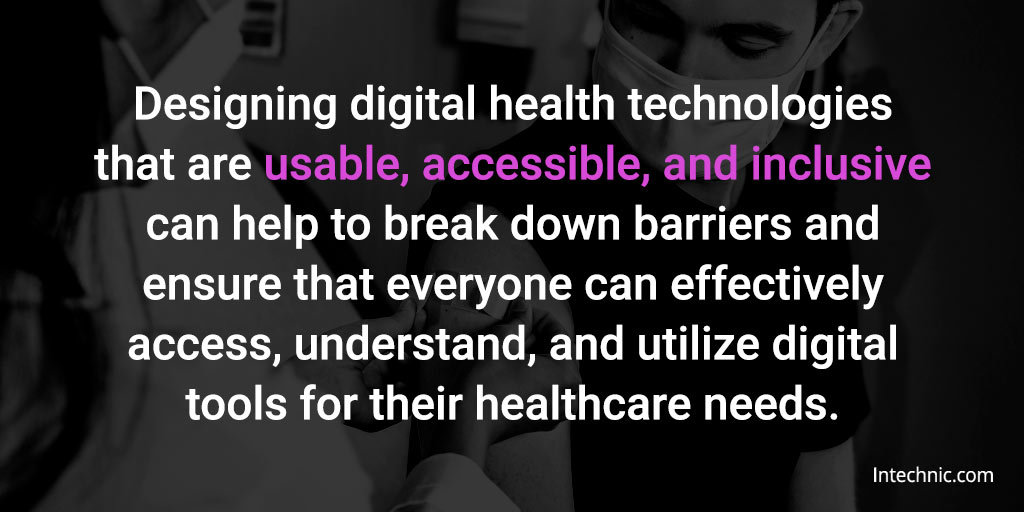
Strategies for achieving health equity and inclusion through user experience
As we move towards a more digital and connected healthcare landscape, it is essential to prioritize UX as a key strategy for achieving health equity and inclusion. This involves engaging with individuals from diverse populations, including those from disadvantaged populations, in the design and development of digital health tools, and ensuring that these tools are accessible, relevant, and effective for all users.
- Designing user-friendly and accessible digital health tools: This includes ensuring that the interface, navigation, and functionalities of digital health tools are designed in a way that is intuitive and easy to use for all users, regardless of their age, education level, or technical skills. It is also important to consider different devices and platforms that patients may use to access digital health tools and ensure that the tools are optimized for these devices.
- Incorporating user-centered design principles: User-centered design is an approach that involves designing digital health tools based on the needs, preferences, and feedback of the users themselves. Conducting user research, usability testing, and feedback collection can help to ensure that the user experience is tailored to meet the specific needs of the target population. This can help ensure that the tools are designed with empathy and inclusivity in mind and are aligned with the preferences and requirements of diverse users.
- Addressing language barriers through multilingual interfaces: Digital health tools should keep the language simple and patient-friendly and incorporate multilingual interfaces that allow users to select their preferred language. This can help individuals who speak different languages access and understand the health information and services provided by digital health tools, making them more inclusive and accessible to diverse populations.
- Providing health information for diverse populations: Digital tools should provide targeted health information that is relevant and culturally appropriate for diverse populations, and presented in a way that is easily understood and relevant to the socio-cultural background, health literacy level, and health needs of different users. Clearly providing value and explaining the benefits of medical treatment can help individuals from underprivileged communities better understand their health conditions, make informed decisions, and engage in self-care.
- Ensuring digital health tools are inclusive for people with disabilities: Healthcare tools and platforms should be designed to be accessible for people with disabilities, including individuals with visual, auditory, cognitive, or motor impairments. It can be achieved by incorporating features such as alternative text for images, closed captioning for videos, keyboard navigation options, and larger font sizes, among others.
- Testing with a diverse group of real users: To ensure that digital healthcare tools are truly inclusive, it is essential to involve individuals from a diverse set of backgrounds in user testing. Collaboration with community organizations, patient advocacy groups, or other stakeholders representing marginalized populations can also greatly contribute to an inclusive design process and help to gain insights into their unique needs, preferences, and challenges.
- Offering digital health literacy training and support: Digital health literacy is the ability to access, understand, evaluate, and apply health information from digital sources. Offering digital health literacy training and support can help individuals from diverse populations develop the skills needed to effectively use digital health tools and make informed health decisions. This can include providing user-friendly tutorials, educational materials, and support channels to help users navigate digital health tools and understand the health information and services provided.
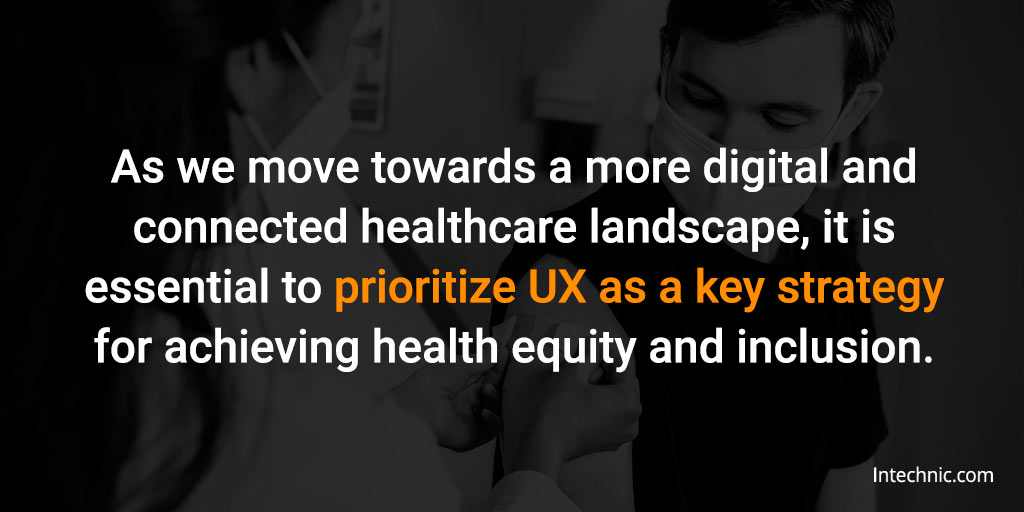
Benefits of a positive user experience for health equity and inclusion
The power of digital health tools extends beyond convenience and efficiency in healthcare. A positive UX can also have significant benefits for health equity and inclusion, ensuring that diverse populations have equal opportunities to access and benefit from digital health technologies.
- Improved access to healthcare services: Digital health technologies, such as telehealth and remote monitoring, can bridge geographical barriers, allowing patients in rural or underserved areas to access healthcare services remotely. User-friendly interfaces, language support, and accessibility features can also ensure that individuals with limited digital literacy, language proficiency, or disabilities can effectively access and utilize digital health tools, thereby improving their access to healthcare services.
- Enhanced patient engagement and empowerment: User-centered design and inclusivity features can make digital health technologies more engaging, relevant, and personalized for patients, empowering them to take control of their health and actively participate in their care. Patient engagement can lead to better health outcomes, increased patient satisfaction, and improved adherence to treatment plans, ultimately promoting health equity by empowering patients.
- Increased health literacy and education: Clear and accessible health information, language support, and educational resources can help individuals understand their health conditions, treatment options, and self-care strategies, leading to improved health literacy. Health literacy is crucial for individuals to make informed decisions about their health and navigate the healthcare system, and a positive UX can contribute to increased health literacy and education for vulnerable populations.
- Reduction of health disparities: Addressing barriers such as limited digital and health literacy and accessibility issues can ensure that digital health technologies can be made more inclusive and accessible to everyone. This can help reduce the disparities in healthcare access, utilization, and health outcomes, ultimately promoting health equity and inclusion.
- Empowerment of disadvantaged communities: Accessible and user-friendly digital health technologies can empower individuals from marginalized communities to actively participate in their healthcare decisions, communicate with healthcare providers, and engage in self-care practices. This can help individuals from disadvantaged groups feel more in control of their health and enable them to navigate the healthcare system more effectively.
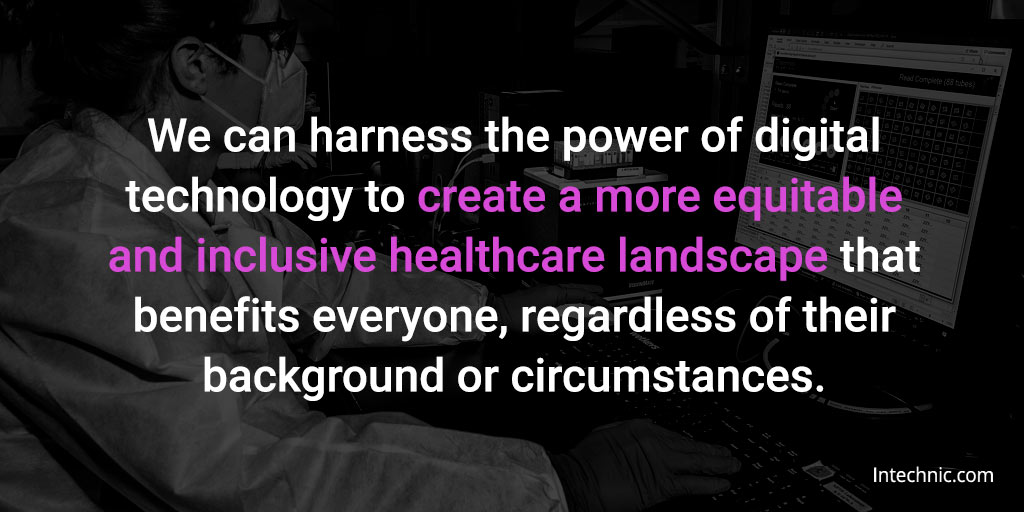
User experience has the potential to drive positive change in healthcare, improve patient centricity, and advance health equity and inclusion. It is our responsibility to prioritize and invest in digital health solutions that are accessible, user-friendly, and inclusive for all individuals, especially those from disadvantaged groups. Together, we can harness the power of digital technology to address health equity and create a more equitable and inclusive health system that benefits everyone, regardless of their background or circumstances.
References
- Elizabeth Arias et al., Provisional Life Expectancy Estimates for 2020 (NCHS Vital Statistics Rapid Release, July 2021); and Elizabeth Arias et al., “Mortality Profile of the Non-Hispanic American Indian or Alaska Native Population, 2019,” National Vital Statistics Reports 70, no. 12. 2021.
- “Mortality amenable to health care,” Commonwealth Fund Health Systems Data Center and calculations from 2018–19 CDC National Vital Statistics System (NVSS); Eugene Declercq and Laurie Zephyrin, Maternal Mortality in the United States: A Primer (Commonwealth Fund, Dec. 2020); “Infant Mortality,” Commonwealth Fund Health Systems Data Center, n.d.; and “Infant Mortality,” CDC, 2021.
- Altarum. The Business Case For Racial Equity: A Strategy For Growth. 2018.
- Shaw J, et al. Recommendations for Health Equity and Virtual Care Arising From the COVID-19 Pandemic: Narrative Review. JMIR Form Res. 2021; 5(4): e23233.


